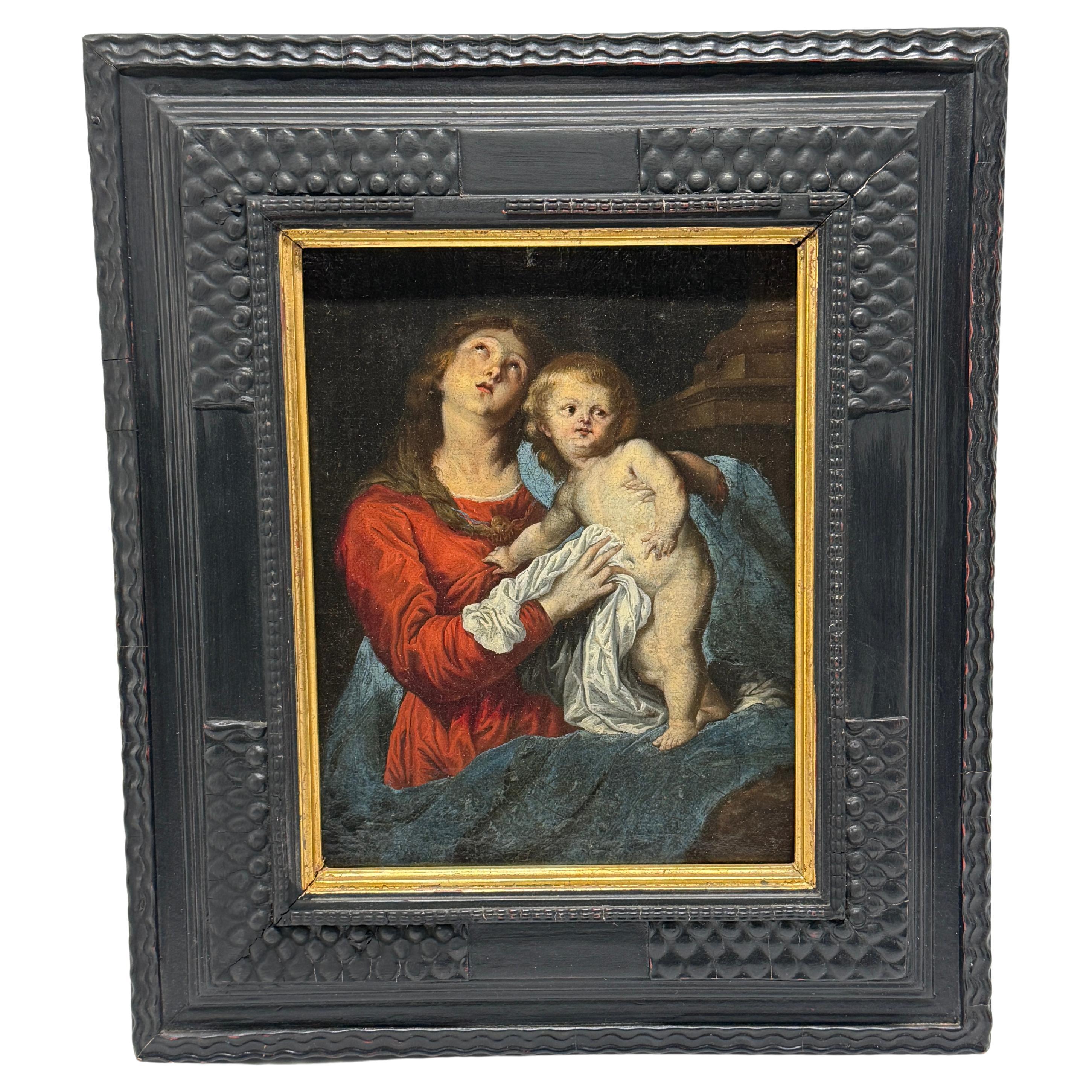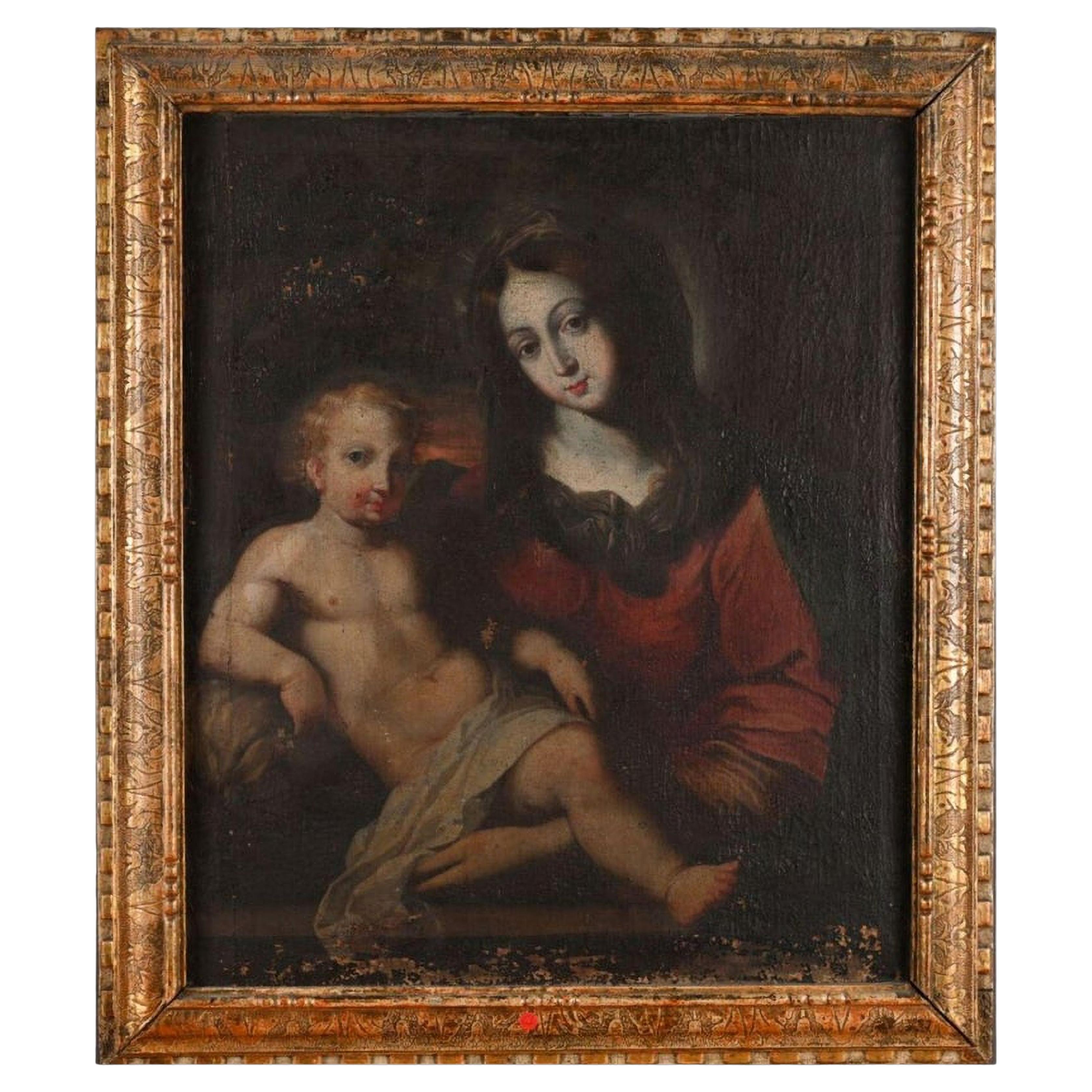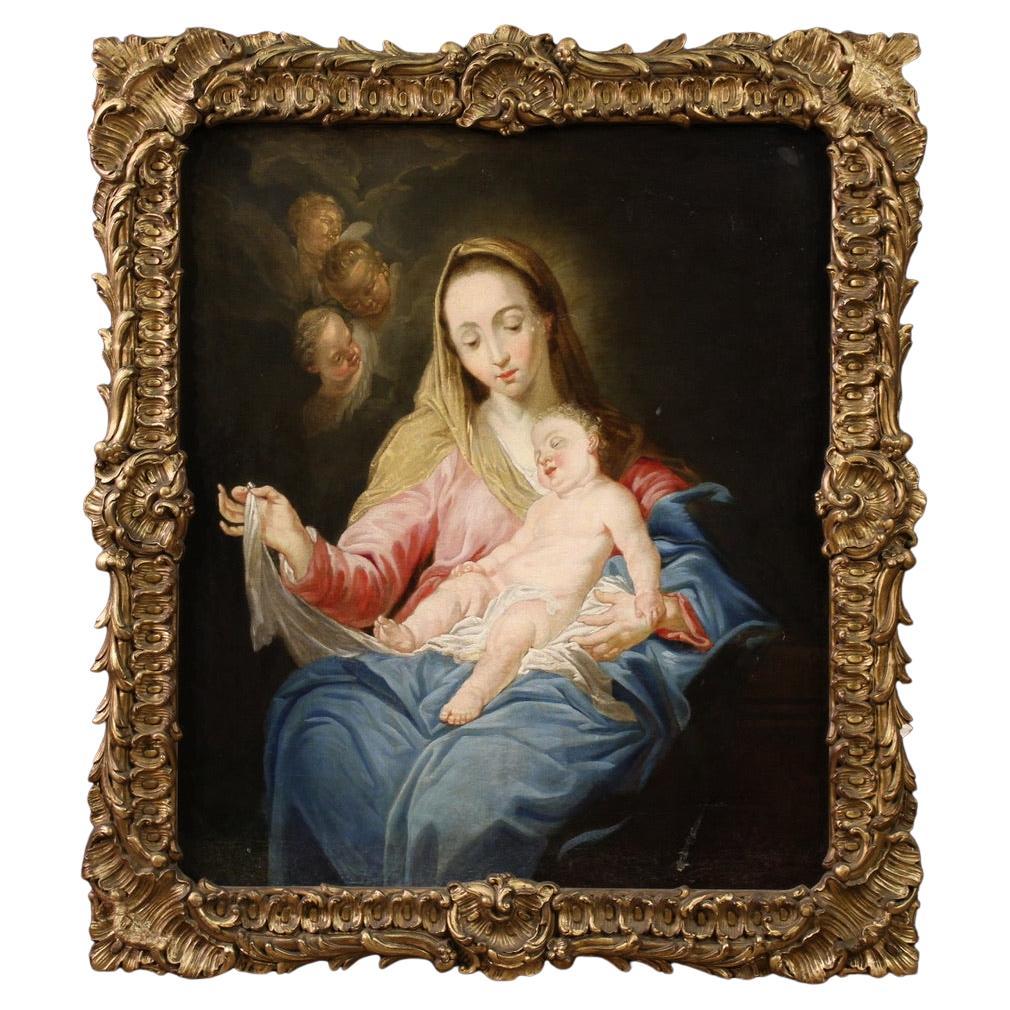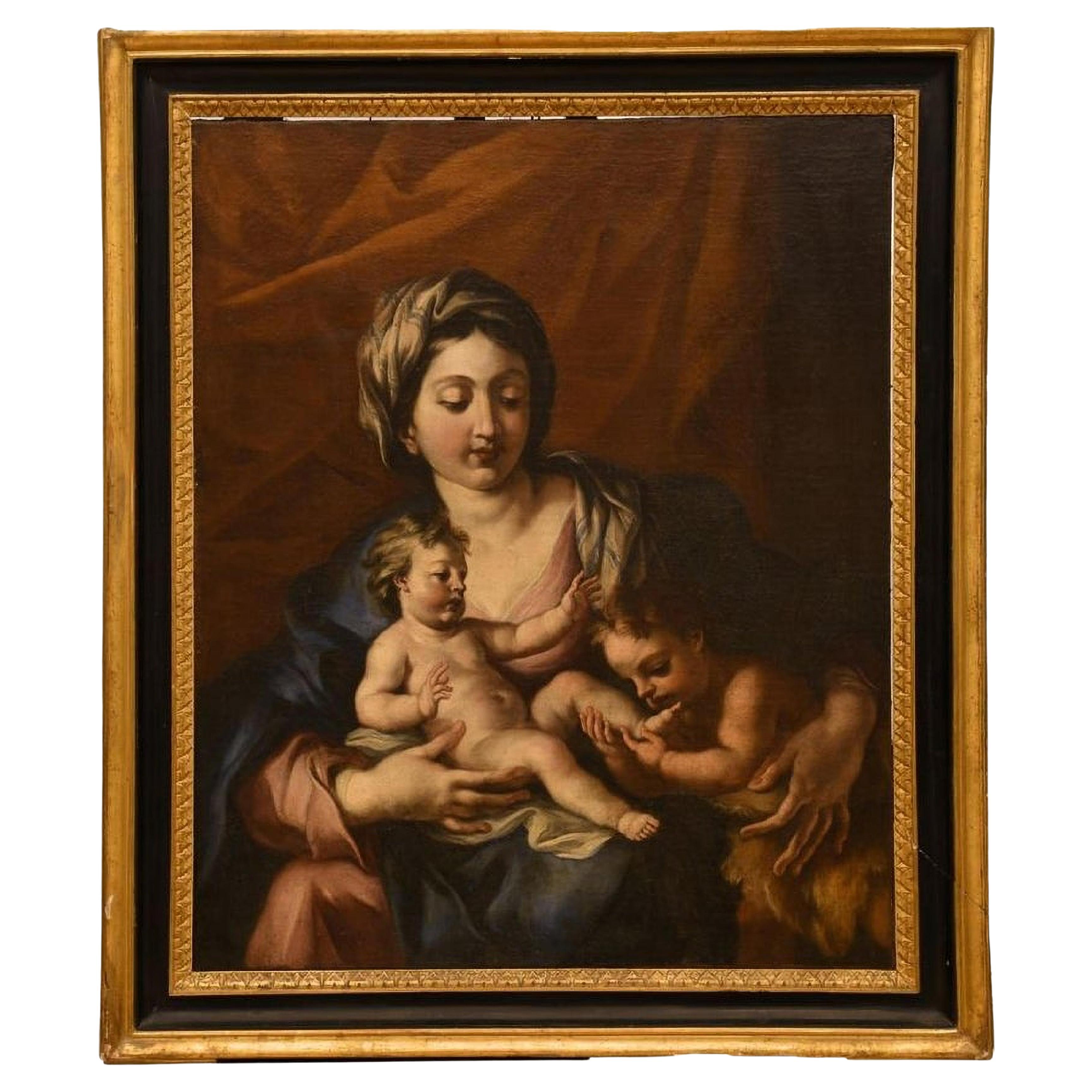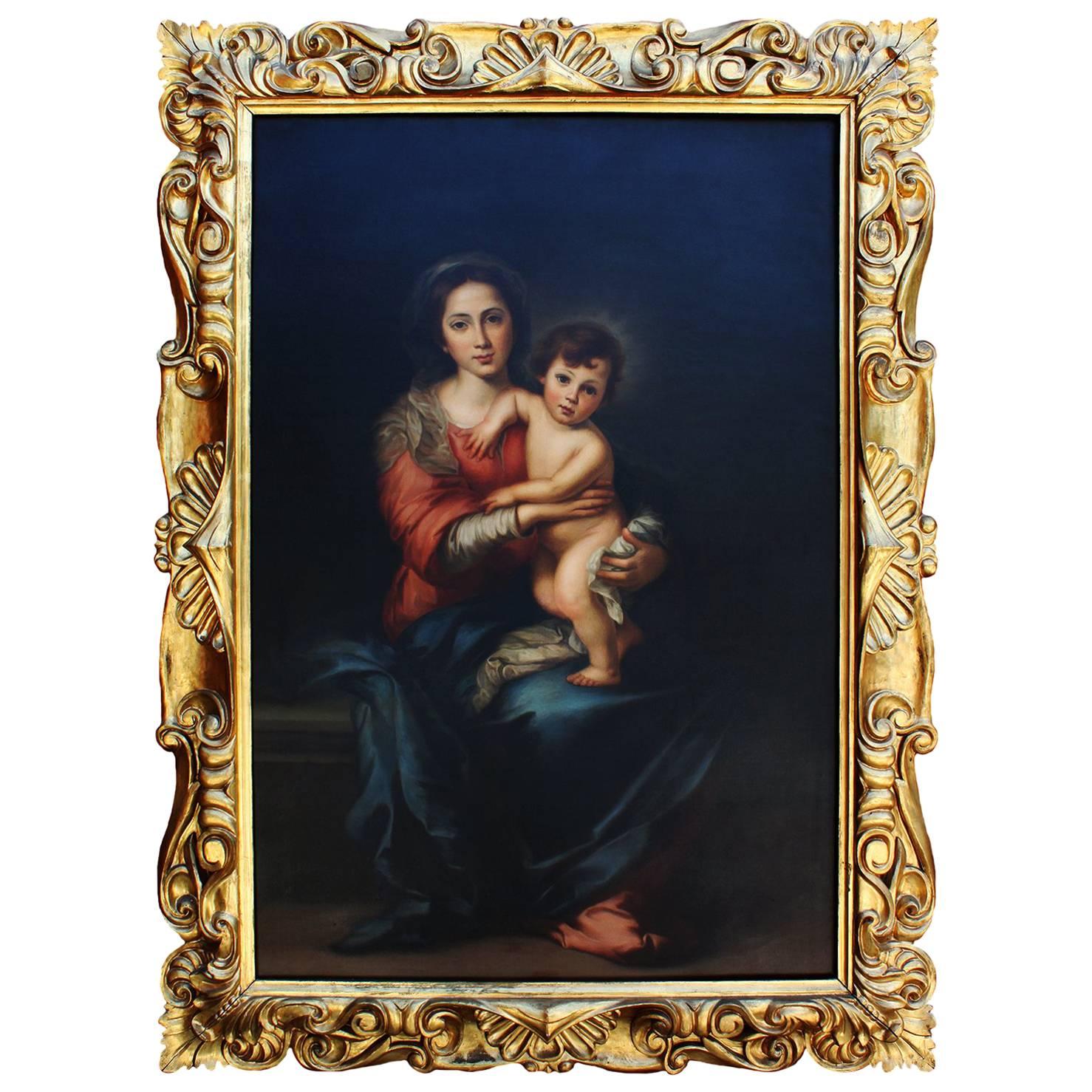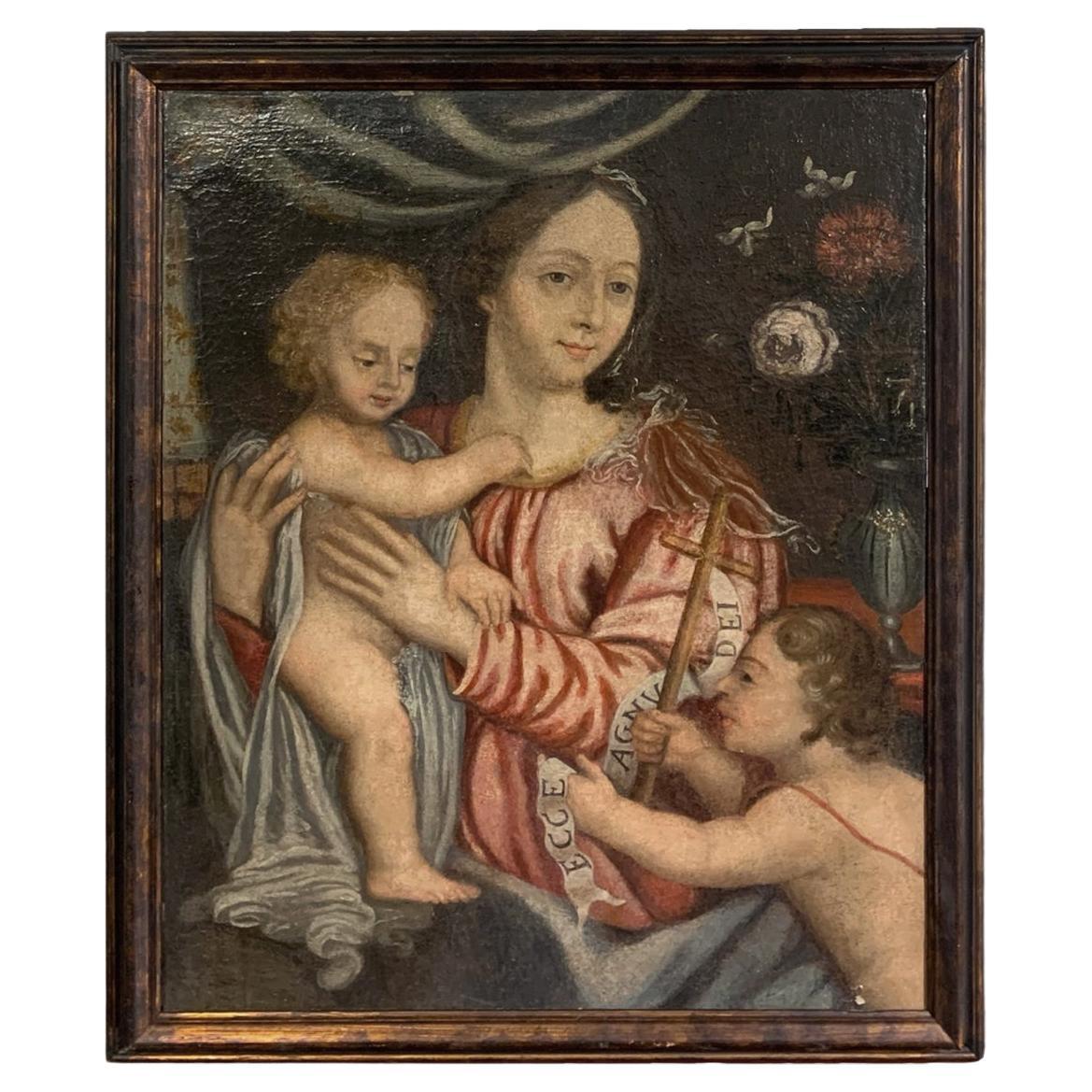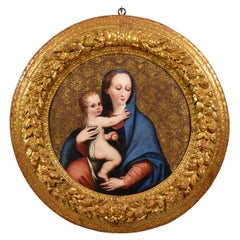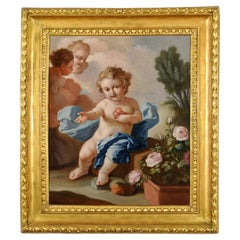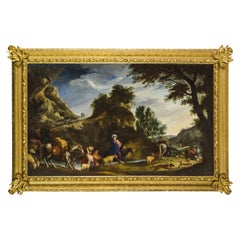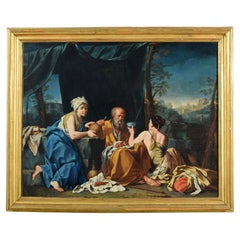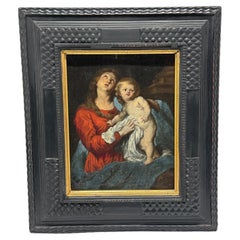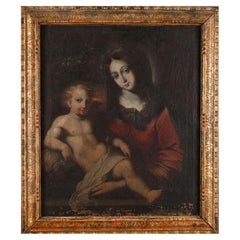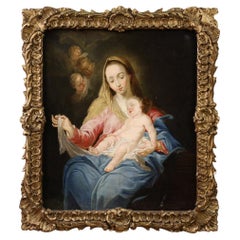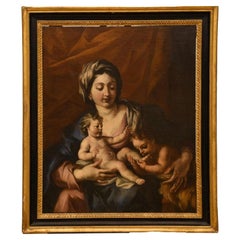Items Similar to 17th Century, Italian Painting with Virgin and Child by Follower of Van Dyck
Want more images or videos?
Request additional images or videos from the seller
1 of 21
17th Century, Italian Painting with Virgin and Child by Follower of Van Dyck
$41,935.03
£31,217.90
€35,000
CA$57,440.50
A$63,886.38
CHF 33,359.48
MX$777,429.24
NOK 426,051.47
SEK 399,561.12
DKK 266,442.78
Shipping
Retrieving quote...The 1stDibs Promise:
Authenticity Guarantee,
Money-Back Guarantee,
24-Hour Cancellation
About the Item
17th century, Italian painting with virgin and childr by Follower of Sir Anthony van Dyck
cm W 90 x H 113; cornice cm W 111 x H 135 x D 7
The canvas depicts the Madonna with the Child in her lap and is stylistically attributable to a painter active in the second half of the seventeenth century. The author is inspired by the famous iconographic prototype elaborated in several versions by Sir Anthony van Dyck (Antwerp, 22 March 1599 - London, 9 December 1641) during his stay in Italy, between 1621 and 1625, recorded in his Italian notebook.
The numerous versions that the important Flemish painter produced testify to the success of this composition with the noble patrons who evidently asked him several times to produce a new version of the subject.
The dramatic image, full of pathos, of the Virgin and the swirling drapery of the clothes and the blue mantle that surround her fully express the typically baroque taste of the artist, influenced, after his stay in Italy, by some painters such as Titian. Among his sources of Italian inspiration should also be mentioned the Emilian classicism of Guido Reni: in his prototypes in fact Van Dyck turns Mary’s gaze to heaven, in an attitude that suffers in the ways of the representation of the Mater Dolorosa and the Mourners disclosed by the Reni. The strong presence of the figures also recalls examples of the great Italian Renaissance, such as Bellini’s Madonnas, even if the volumes of the bodies here are exquisitely baroque. Particular attention is given to the contrast between the intense tones of the Virgin’s clothes and the dark background from which an imposing column is barely visible.
In these works, to the ecstatic and celestial contemplation of the Virgin, Van Dyck contrasts the serene and nonchalant gaze of the Child who, in a completely realistic way, seems unaware of the destiny reserved for him, looking outside the canvas.
The success of the composition is undoubtedly due to the high level of quality, distinguished by the perfect fusion of elegance, magniloquence and descriptive force.
The author of the painting is inspired by one of the many engravings that were produced by Van Dyck’s paintings. Among these, that of Paulus Pontius (1603-1658), is the closest. The image of the Madonna with Child in our painting, in fact, appears in contrast to those of the Flemish painter. This is because the author evidently had the opportunity to know a print of the engraving that appears specular because of the technique itself. In turn, Paulus Pontius' engraving was also successful among engravers, as Petrus Clouet (1629-1670) reasserted it, returning to show the image, again in counterpart, no longer mirror van Dyck’s work.
The author of our painting has given the Madonna and Child, standing, a character strongly linked to the classicism of Guido Reni and the very lively and bright color palette. The browns of van Dyck’s backgrounds, in this work are clear, where the classical column is replaced by the trunk of a tree with leafy fronds, as well as the landscape described in the background, with green woods, a blue sky marked by some fluffy cloud, in shades of grey. The bodies of the Virgin and Child, as well as the draperies, are bathed in an intense light, almost metaphysical, that illuminates the pure skin and the folds of the fabrics.
Many painters tried to reproduce this iconographic prototype, evidently sought after by noble and bourgeois collectors who commissioned copies and similar versions.
We apologize for any translation errors from Italian. Please contact us to have the expertise of the painting, in Italian.
- Similar to:Anthony van Dyck (Artist)
- Dimensions:Height: 53.15 in (135 cm)Width: 43.71 in (111 cm)Depth: 2.76 in (7 cm)
- Style:Baroque (Of the Period)
- Materials and Techniques:
- Place of Origin:
- Period:Late 17th Century
- Date of Manufacture:Late 17th Century
- Condition:Wear consistent with age and use.
- Seller Location:IT
- Reference Number:1stDibs: LU4405232801602
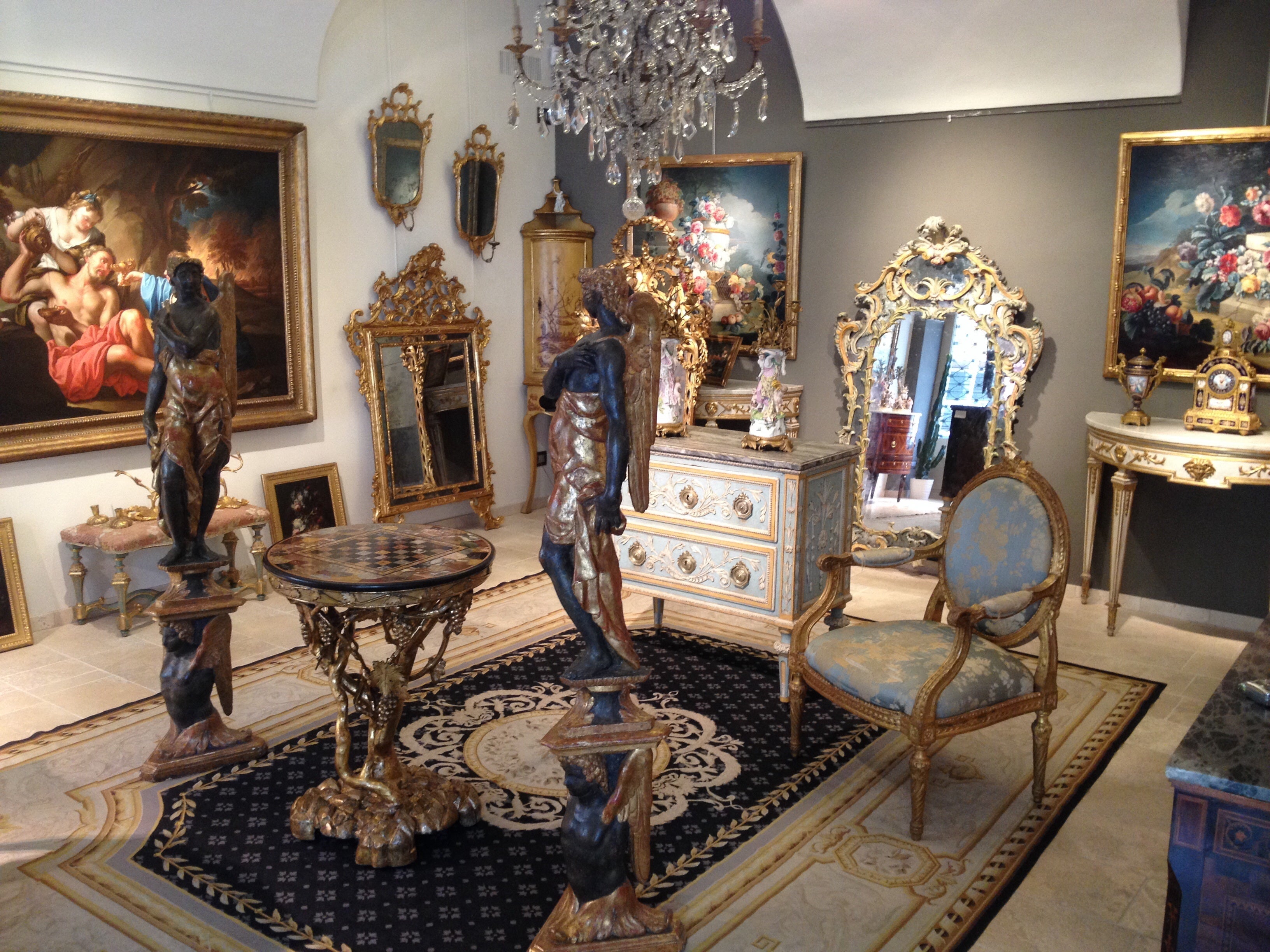
About the Seller
5.0
Platinum Seller
Premium sellers with a 4.7+ rating and 24-hour response times
Established in 1980
1stDibs seller since 2019
56 sales on 1stDibs
Typical response time: 1 hour
- ShippingRetrieving quote...Shipping from: Italy
- Return Policy
Authenticity Guarantee
In the unlikely event there’s an issue with an item’s authenticity, contact us within 1 year for a full refund. DetailsMoney-Back Guarantee
If your item is not as described, is damaged in transit, or does not arrive, contact us within 7 days for a full refund. Details24-Hour Cancellation
You have a 24-hour grace period in which to reconsider your purchase, with no questions asked.Vetted Professional Sellers
Our world-class sellers must adhere to strict standards for service and quality, maintaining the integrity of our listings.Price-Match Guarantee
If you find that a seller listed the same item for a lower price elsewhere, we’ll match it.Trusted Global Delivery
Our best-in-class carrier network provides specialized shipping options worldwide, including custom delivery.More From This Seller
View All17th Century, Italian Oil on Panel Painting Depicting Madonna della Purità
Located in IT
17th Century, Italian Oil on Panel Painting Depicting Madonna della Purità
The painting, executed in oil on a circular wooden panel and presented in an imposing carved and gilded wo...
Category
Antique 17th Century Italian Renaissance Paintings
Materials
Wood, Giltwood
18th Century, Italian painting with Sacred Heart of the Child Jesus by Pietro Ba
By Pietro Bardellino
Located in IT
Pietro Bardellino (Italy - Naples, 1732 - 1806), attr., Sacred Heart of the Child Jesus
Measurements: with frame, cm L 86 x H 99 x P 8; only the canvas, cm L 78 x H 64
The painting, made in oil on canvas, represents the Sacred Heart of the Child Jesus. Stylistically the work is attributable to Pietro Bardellino (Italy, Naples, 1732 - Naples, 1806), a pupil of Francesco De Mura and considered by critics one of the most gifted and sensitive exponents of the Rococo style in Naples.
The canvas represents the Child Jesus, surrounded by flowers in an outdoor setting, while showing the sacred heart. The canvas has a well-balanced color and a strong sweetness of the child’s traits, which with the complicit gesture of the right hand, involves the viewer in the intimate and delicate sharing of the garden in which he sits. The roses, in addition to being a beautiful piece of still life, contribute to enrich the Christological message, being bearers of symbolic meanings. Marian attributes par excellence, are often side by side with Christ, whose thorns foreshadow the Passion. In the canvas, on the top left, two cherubim are observed: among them, according to the Old Testament, is God: the author therefore puts into place an iconographic and iconological hyperbole that amplifies its meaning. The iconographic theme of the Child Jesus with the Sacred Heart in his hand spread between the second half of the eighteenth century and the first of the following century. With the worship of the Sacred Heart of Jesus, the Catholic Church intends to honour the Heart of Jesus Christ, one of the organs symbolizing his humanity, which by intimate union with the Divinity, has the right to worship and love of the Saviour for men, of which His Heart is the symbol. It represents one of the fundamental devotions of Christian life, as it manifests the true face of God, who is prodigal and boundless love. It was the French mystic Saint Margaret Mary Alacoque...
Category
Antique Mid-18th Century Italian Baroque Paintings
Materials
Canvas
17th Century, Italian Painting by Pier Francesco Cittadini, Jacob and his Family
Located in IT
Pier Francesco Cittadini (Milan, 1616-Bologna, 1681)
"Jacob and his family go to Egypt"
Oil on canvas, cm 109 x 190 (canvas only)
The valuable painting, made in oil on canvas, depicts Jacob and his family go to Egypt and we believe it can be, given the high quality painting, autograph work of Italian Pier Francesco Cittadini (Italy Milan, 1616 - Bologna, 1681) made after 1647. The work, in excellent condition is accompanied by a coeval frame in wood finely carved and golden.
The scene depicted, which was confused with the Flight to Egypt in the past years, is instead identified with the biblical episode of Jacob’s journey. In the foreground, reading the painting from left to right, we see a caravan composed of animals, including donkeys, dromedaries, goats, dogs and horses and people, women, men and slaves, who carry on their journey along the banks of a river, following a path that to the right, would seem to lead to the through of a bridge. In addition to the watercourse is described an environment characterized by large rocks and impervious come far to cover the entire verticality of the canvas. On the left, in the distance, we see the tail of the caravan that runs along the steep path. Large trees enliven and harmonize the environment, as well as white and grey clouds characterize the predominantly clear sky and illuminated on the right by sunlight.
The story is told in the Bible, Book of Genesis, 30, 25, passage in which is described the flight of Jacob from Haran after the contrasts with Laban, father of his wife Rachel. Jacob is the third great patriarch of the Bible. From his descendants originate the twelve generations of the people of Israel. He is the son of Isaac and Rebekah, who led him to flee from the wrath of Esau to Haran to seek refuge from his brother, Laban. At his uncle’s house Jacob met his daughter Rachel. As soon as he saw his cousin, Jacob was taken. Jacob will stay seven years in the service of Laban to marry his beloved Rachel. But Laban, with a deception, will give him in marriage first Lia, the least beautiful eldest daughter, and only after another seven years the splendid Rachel. From his first wife he will have several children, while Rachel will give birth to the beloved son, Joseph, who will become viceroy of Egypt.
After years of service, Jacob asked to be paid with every dark-coloured garment among the sheep and every spotted and dotted garment among the goats. Laban accepted and sent away from his sons all the leaders of that kind. So Jacob took fresh branches of poplar, almond and plane tree, and flayed them, and put them in the troughs. The optical suggestion induced the goats and the sheep to conceive and give birth to dark, striped and dotted garments. He also ensured that all the strongest and healthiest leaders of the flock of Laban would drink near the barked branches, thus assuring a genetic superiority to his part of the flock. His flocks grew numerous and strong and he became richer than his relative, arousing envy. It was clear that Laban would not respect him much longer. At the suggestion of the Lord, Jacob decided to return to Canaan. Trying to avoid any possible dispute, he left with his family while Laban was absent for shearing sheep. But when, three days later, his uncle returned home, he became angry, feeling offended because Jacob had gone secretly and had not allowed him to greet his daughters and grandchildren. In addition, his teraphim, statuettes, or idols, which depicted the family deities, had disappeared. After 7 days of pursuit, Laban and his men reached Jacob’s group on Mount Gilead, in the mountainous region west of the Euphrates River, where his uncle and grandson had a stormy conversation. The younger man was outraged at being accused of stealing idols and told Labano to rummage through his family’s tents at will. Neither of them could know or even imagine that it was Rachel who took the idols and hid them in the saddle of the camel. During the search, she sat down firmly on the saddle, apologizing for not being able to get up, «because I usually have what happens to women» (Gen 31:35). So the loot wasn’t discovered.
The author of this work was inspired by the composition of an engraving by Stefano Della Bella (1610-1664) of circa 1647. The engraving by Stefano della Bella bears the title "Iacob sur ses vieux jours quitte sans fascherie pour voir son filz Ioseph, sa terre et sa patrie" and is signed on the bottom left "Stef. of the Beautiful In. et fe." while on the right it is declared "Cum privil. Regis", that is with license of the king.
Stefano Della Bella (Italy - Florence, May 18, 1610-Florence, July 12, 1664) was born in a family of painters, sculptors and goldsmiths and was left early orphan of his father sculptor, he dedicated himself first to the art of goldsmith at the school of Giovanni Benedetto Castiglione and Gasparo Mola, then turning his attention to drawing and engraving. He soon began drawing figures and copying the etchings of Jacques Callot, which inspired his early works. Under the protection of the Medici, in particular of Don Lorenzo, cadet son of Grand Duke Ferdinand I, Della Bella has the opportunity to make study trips to Rome, where he stayed from 1633-1636; In Rome he met French engravers and publishers of prints such as Israël Henriet and François Langlois, who influenced his decision to move to Paris in 1639, four years after the death of Callot. In Paris he soon reached, thanks to the engravings commissioned by Cardinal Richelieu, the success also worldly; he frequented courtiers, theatre artists and writers, while refusing too oppressive honors. In 1646-1647 he continued his travels in the Netherlands to Amsterdam, Antwerp and Dordrecht. He returned to Florence in 1650 and resumed working under the protection of the Medici court, working for his patrons. In 1656 he became a member of the Academy of Apatists.
The painting object of this study is reasonably attributable to Pier Francesco Cittadini, or Pierfrancesco Cittadini, called the Milanese or the Franceschino (Italy - Milan, 1616-Bologna, 1681) as some exemplary stylistic comparisons proposed to follow can prove.
Pier Francesco Cittadini was an Italian baroque painter, mainly active in Bologna.
His artistic training first took place with the painter Daniele Crespi...
Category
Antique Mid-17th Century European Baroque Paintings
Materials
Canvas, Giltwood
18th Cent., Italian Painting, Loth and the daughters, att. to Giuseppe Gambarini
By Giuseppe Gambarini
Located in IT
Giuseppe Gambarini (Bologna, 17 March 1680 - Casalecchio di Reno, 11 September 1725)
Loth and the daughters
Oil on canvas; Measurements: cm H 73 x W 93; frame H 88 x W 108 x D 5,5
The painting, of beautiful pictorial quality, depicts the biblical scene of Lot and his daughters, with Sodom set on fire in the background, and is stylistically attributable to the italian painter Giuseppe Gambarini (Italy, Bologna, 17 March 1680 - Casalecchio di Reno, 11 September 1725).
The canvas shows in the center Lot sitting and already drunk, depicted according to traditional iconography, old, gray and with long gray boat. With his left hand he grabs the wine flask that one of his daughters offers him. She is depicted kneeling and resting on large boulders of stone, described as an architectural base, dressed in a voluminous deep blue mantle, her hair covered with a humble headdress made of a knotted cloth; look at the viewer, as if to want to involve him directly in the scene. The other daughter is described on the left, from the back to the observer, with a bare back and dark hair gathered by a red ribbon. She too is intent on serving her father a cup in which to pour the wine. Around them a duck placed on a cloth, some bread and another wine flask enrich the composition describing a banquet in progress. The scene is set outdoors, where only a large tent supported by branches arranged in a hut serves as a shelter to the figures. In the background a forest landscape blends chromatically with the blue sky. To the right in the distance, is described the city of Sodom, already destroyed and on fire. Lot’s wife...
Category
Antique Early 18th Century Italian Baroque Paintings
Materials
Canvas
$22,045 Sale Price
20% Off
19th Century, Italian Painting with Still Life with Cherubs
Located in IT
19th century Roman painter
Still life with cherubs, flower festoons and herma with faun
Measures: Oil on canvas, cm H 78 x W 95 without frame
Cm H 122.00 x W 106 x D 8 with frame.
The work, painted in oil on canvas, octagonal in shape, represents a nature with three putti or cupids playing with flower festoons in a wooded environment in which is placed a herma with faun and, on the left, a large neoclassical marble vase...
Category
Antique 19th Century Italian Baroque Paintings
Materials
Canvas
17th Century, Italian Painting with Saint Cecilia with Angels in Concert
Located in IT
17th century Roman school, Santa Cecilia with angels in concert, oil painting on canvas
The valuable painting, in excellent condition, depicts Sa...
Category
Antique 17th Century Italian Baroque Paintings
Materials
Canvas
You May Also Like
Madonna and Child, Attr. to the School of Anthony van Dyck - 18th C or Earlier
Located in Atlanta, GA
18th Century or Earlier, Oil Painting on Canvas and Later Laid to Panel.
This captivating oil painting of the Madonna and Child is attributed to the School of Anthony van Dyck, one...
Category
Antique 18th Century Dutch Baroque Paintings
Materials
Canvas, Wood, Paint
Early 17th century French School "Virgin and Child "
Located in Madrid, ES
Early 17th century French School
"Virgin and Child "
Oil on canvas (Original canvas, restorations, gaps)
71.5 x 60.3 cm
Provenance Duc de Lesdiguières, according to an old label ...
Category
Antique 17th Century French Baroque Paintings
Materials
Paint
18th Century Oil on Canvas Italian Religious Painting Madonna with Child, 1750
Located in Vicoforte, Piedmont
Splendid Italian painting from the 18th century. Oil painting on canvas depicting a wonderful Madonna with sleeping child, of remarkable pictorial quality. For the delicacy of the co...
Category
Antique 1750s Italian Paintings
Materials
Canvas
18th century Central Italian Painter - Madonna with the praying Saint John
Located in Madrid, ES
18th century Central Italian Painter - Madonna with the praying Saint John
oil painting on canvas
Dimensions:
63x76 cm
good condition
Category
Antique Early 18th Century Italian Baroque Paintings
Materials
Paint
Attributed to Giorgio Lucchesi, Oil on Canvas "Madonna & Child" After Murillo
By Bartolomé Esteban Murillo
Located in Los Angeles, CA
Attributed to Giorgio Lucchesi (1855-1941) A large and impressive early 20th century oil on canvas "Madonna and Child" after Bartolomé Esteban Murillo...
Category
Vintage 1910s Italian Baroque Paintings
Materials
Canvas, Giltwood
18th CENTURY PAINTING MADONNA WITH CHILD AND SAINT JOHN
Located in Firenze, FI
Beautiful oil painting on canvas dating back to the Piedmontese school of the early 18th century. The work depicts the Madonna with the Baby Jesus in her arms and next to them is the...
Category
Antique Early 18th Century Italian Paintings
Materials
Canvas, Paint
